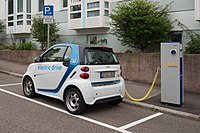As of October 2022 [update], there were 100,000 electric vehicles in Austria, equivalent to 2% of all vehicles in the country. [1] As of 2021 [update], 13.9% of new cars registered in Austria were electric. [2]
As of September 2022 [update], the Tesla Model Y was the best-selling electric car in Austria. [3]
Government policy
As of October 2022 [update], the Austrian government offers subsidies of up to €5,000 for electric car purchases. [4]
Charging stations
As of November 2022 [update], there were around 15,000 public charging stations in Austria. [5]
By state
Carinthia
As of 2021 [update], 11.8% of new cars registered in Carinthia were electric. [2]
Lower Austria
As of 2021 [update], there were 20,000 electric vehicles registered in Lower Austria, equivalent to 1.4% of vehicles in the state. [6]
Salzburg
As of 2021 [update], 17% of new cars registered in Salzburg were electric. [2]
Vienna
As of 2017 [update], there were 500 public charging stations in Vienna. [7]
Vorarlberg
As of 2021 [update], 17% of new cars registered in Vorarlberg were electric. [2]
References
- ^ "VCÖ: Erstmals mehr als 100.000 Elektroautos zugelassen". Salzburger Nachrichten (in German). 19 October 2022. Retrieved 9 November 2022.
- ^ a b c d "Flood of new electric cars in Austria". TheMayor.EU. 24 January 2022. Retrieved 9 November 2022.
- ^ "Die meistverkauften Elektroautos in Österreich". Kleine Zeitung (in German). 9 November 2022.
- ^ "Förderung für gewerbliche E-Autos soll heuer auslaufen". vienna.at (in German). 13 October 2022. Retrieved 9 November 2022.
- ^ "Größter Ausbau von E-Ladeinfrastruktur in Österreich: SPAR und BEÖ bauen bis 2025 E-Ladestationen auf 335 Standorte aus" (in German). OTS. 9 November 2022. Retrieved 9 November 2022.
- ^ "E-Auto trotz hoher Stromkosten günstiger". orf.at (in German). 17 September 2022. Retrieved 11 November 2022.
- ^ "Stadt verspricht 500 neue E-Ladesäulen". orf.at (in German). 5 October 2017. Retrieved 9 November 2022.

